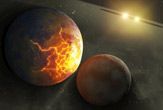When Worlds Collide, Chances for Alien Life Dwindle

Tight double-star systems with the dusty remains of huge planet collisions may not be the best places to look for extraterrestrial life, a new study has found.
Researchers examining data from NASA's Spitzer Space Telescope noticed a surprisingly large amount of dust around three mature, close-orbiting star pairs. Astronomers think the dust could be the aftermath of tremendous planetary collisions. [Graphic of the potential planetary crash.]
"This is real-life science fiction," said study leader Jeremy Drake of the Harvard-Smithsonian Center for Astrophysics. "Our data tell us that planets in these systems might not be so lucky — collisions could be common. It’s theoretically possible that habitable planets could exist around these types of stars, so if there happened to be any life there, it could be doomed."
The particular class of double stars in the study is about as snug as stars can get.
The stars, called RS Canum Venaticorums or RS CVns for short, are separated by just 2 million miles (3.2 million km), or 2 percent of the distance between Earth and our sun. The stellar pairs orbit each other every few days, with one face on each star perpetually locked and pointed toward the other.
For comparison, the Earth and sun are usually about 93 million miles (150 million km) apart.
The close-knit stars are similar to the sun in size and are probably about a few billion years old — roughly the age of our sun when life first evolved on Earth. But these stars spin much faster, and, as a result, have powerful magnetic fields. The magnetic activity drives strong stellar winds — gale-force versions of the solar wind — that slow the stars down, pulling them closer together over time. And this is where the planetary chaos may begin.
Sign up for the Live Science daily newsletter now
Get the world’s most fascinating discoveries delivered straight to your inbox.
As the stars cozy up to each other, their gravitational influences change, and this could cause disturbances to planetary bodies orbiting both stars. Comets and any planets that may exist in the systems would start jostling about and banging into each other, sometimes in powerful collisions.
These collisions could include any planets in the double stars' habitable zone, a region where temperatures would allow liquid water to exist. Though no habitable planets have been discovered around any stars beyond our sun at this point in time, tight double-star systems are known to host planets.
"These kinds of systems paint a picture of the late stages in the lives of planetary systems," said Marc Kuchner, a co-author from NASA Goddard Space Flight Center. "And it's a future that's messy and violent."
Spitzer spotted the infrared glow of hot dusty disks, about the temperature of molten lava, around three such tight binary systems. In addition, researchers using Spitzer recently found a warm disk of debris around another star that turned out to be a tight binary system.
The researchers say that dust normally would have dissipated and blown away from the stars by this mature stage in their lives. They conclude that something — most likely planetary collisions — must therefore be kicking up the fresh dust. In addition, because dusty disks have now been found around four, older binary systems, the scientists know that the observations are not a fluke: something chaotic is very likely going on.
The study is detailed in the Aug. 19 edition of the Astrophysical Journal Letters.












